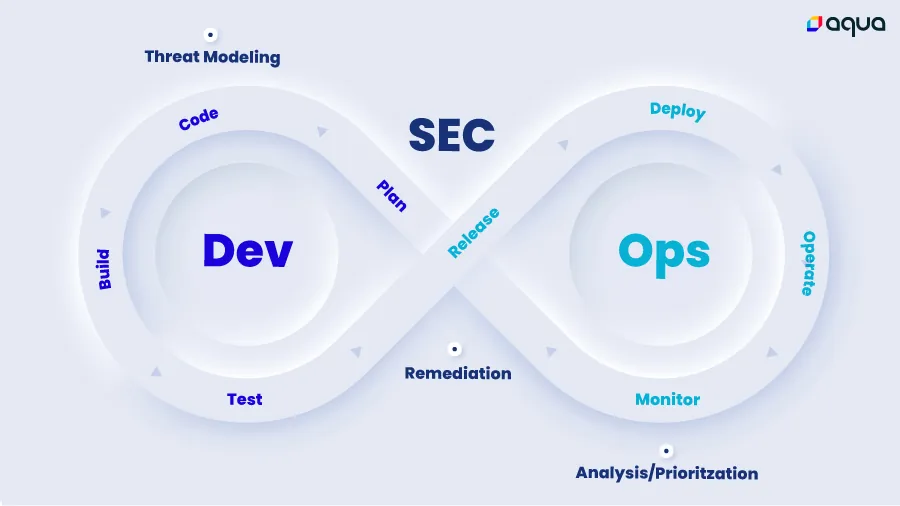Here’s a look at what a DevSecOps pipeline is, how it works, why it’s important, and how to implement DevSecOps pipelines using tools like Aqua.
In this article:
- What is the DevSecOps pipeline?
- The importance of the DevSecOps pipeline
- Integrating DevSecOps pipelines with CI/CD Pipelines
- Creating a DevSecOps pipeline with Aqua
What is the DevSecOps pipeline?
The DevSecOps pipeline is a series of application development processes that include tightly integrated security checks and controls. The exact components of a DevSecOps pipeline can vary, but they typically include:
- Application design, including evaluation of how design considerations (such as using a microservices vs. a monolithic architecture) impact application security.
- Code implementation, with automated scans of source code performed to detect risks early in the development process.
- A series of tests against application release candidates after they have been built and deployed into a testing environment. In addition to tests that validate application reliability and performance, these tests include security scans like SAST and DAST, which can help identify risks prior to application deployment.
- Deployment of the application into a production environment.
- Ongoing monitoring of the runtime environment to detect both application performance issues and application security risks that could impact end users.
These processes can be represented as a DevSecOps pipeline diagram that looks like the following:

DevSecOps and CI/CD
In essence, the DevSecOps pipeline builds on the concept of the DevOps CI/CD pipeline, which is the series of processes that DevOps teams use to design, create, test, deploy, manage, and update software. But the DevSecOps pipeline integrates security into these processes – something that most organizations did not traditionally do because when DevOps became popular starting in the late 2000s, its focus was on collaboration between developers and IT operations teams alone. It didn’t cover security.
The DevSecOps pipeline helps to change this by adding security to the DevOps equation. Rather than managing security risks through a separate, siloed process, a DevSecOps pipeline ensures that security protections are baked directly into the application development process.
The importance of the DevSecOps pipeline
The chief benefit of a DevSecOps pipeline is that it helps bridge the gap that traditionally separates application security operations from development operations. Historically, developers built apps using one set of processes, and security analysts tested and monitored apps for risks using a separate set of processes.
This approach was problematic for several reasons:
- It increased the chance that security risks would make it into production environments because security teams were unable to detect them before developers deployed the apps.
- It was inefficient and could delay application releases in the event that security teams did not discover risks until just before applications were about to be deployed into production. In that case, developers might have to scrap the application release, update source code, and rebuild the app – whereas if they’d been aware of the security risk earlier, they could have fixed it much more efficiently, without holding up the development process.
- It hampered communication and collaboration between developers and IT teams on the one hand, and security teams on the other. Rather than working together toward shared goals, and enjoying visibility into what the other set of stakeholders was doing, the two teams had little in the way of shared understanding or focus.
By integrating security directly into the development process, the DevSecOps pipeline mitigates these challenges. It enables effective collaboration between developers, IT operations teams, and security professionals, helping to operationalize the goals behind DevSecOps. It shifts security “left,” which helps organizations discover security issues earlier and fix them more efficiently. And it minimizes the risk that security flaws will make their way into production environments, where threat actors can exploit them.
Integrating DevSecOps pipelines with CI/CD Pipelines
As we mentioned, the DevSecOps pipeline is essentially a CI/CD pipeline with security baked into the various software development processes.
But how, exactly, do you integrate DevSecOps into an existing CI/CD pipeline? The answer boils down to identifying stages within the CI/CD process where security tests or validations can occur without disrupting the overall software development process. Typically, opportunities for integrating DevSecOps into CI/CD include:
- During application design, developers should work with security engineers to determine which overall application design is most secure, as well as which security features (such as built-in access controls) the app will require.
- During the coding and integration phase of CI/CD, automated tests can scan for security flaws in source code – such as improper input validation that could trigger code injection risks.
- After an application has been built and compiled, additional scans can test application binaries for risks. These scans can run against raw binary code, as well as against application images or packages, such as containers.
- After application deployment, continuous monitoring can detect anomalies (such as unusual access requests) that could be a sign of an attack.
The exact process for integrating security into these stages of the CI/CD pipeline will vary depending on which types of CI/CD and security tools an organization uses. As long as you have an application security platform that is compatible with a broad range of CI/CD software, however, you should be able to add security checks to your development process easily, without having to make major modifications to the CI/CD setup you have in place.
Creating a DevSecOps pipeline with Aqua
As an end-to-end cloud-native security platform that integrates with virtually all major development tools and services, Aqua makes it easy to turn your CI/CD pipeline into a DevSecOps pipeline. Aqua provides the capabilities modern organizations need to perform security tests and scans across all stages of the development lifecycle. In addition, features like risk prioritization and AI-guided remediation help teams determine which risks matter most.
